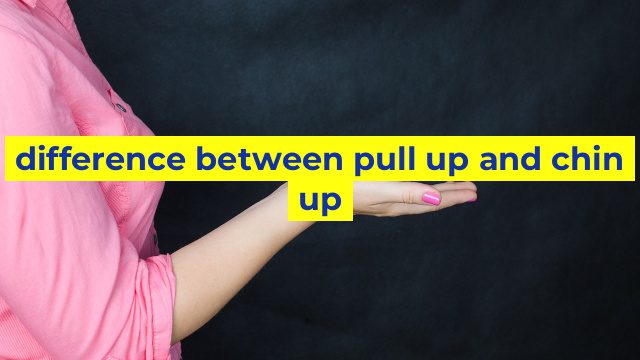The Difference Between Pull-Ups and Chin-Ups: Which One Should You Do?
Pull-ups and chin-ups are two of the most effective exercises for developing upper body strength, especially in the back, arms, and shoulders. While these two exercises may look similar, there are differences that can affect the muscles worked, and ultimately the results achieved. In this article, we’ll compare pull-ups and chin-ups and help you decide which one you should incorporate into your workout routine.
Pull-Ups vs. Chin-Ups: The Grip
The main difference between these two exercises is the grip. Pull-ups are performed with a pronated grip, which means your palms are facing away from your body. When doing pull-ups, your hands should be slightly wider than shoulder-width apart, and your elbows should be fully extended at the start of the exercise. As you pull your body up toward the bar, your hands and arms will be working together to perform the movement.
Chin-ups, on the other hand, are done with a supinated grip, which means your palms are facing towards your body. When doing chin-ups, your hands should be shoulder-width apart or slightly narrower, and your elbows should be bent at the start of the exercise. As you pull your body up towards the bar, your biceps will be more engaged in the movement.
Muscles Worked
Both pull-ups and chin-ups engage many of the same muscles in the upper body, such as the lats, traps, and rhomboids. The main difference is in the way these muscles are activated. Pull-ups place more emphasis on the upper back muscles, while chin-ups require more activation of the biceps.
To sum up, pull-ups are the better choice for those looking to target their upper back muscles and improve posture, while chin-ups are a better choice for those looking to target their biceps and build arm strength.
Which One Should You Do?
The answer to this question depends on your fitness goals and level of strength. If you’re a beginner, it might be best to start with chin-ups since they are less challenging than pull-ups. Once you’ve built up some strength, you can move on to pull-ups.
If you’re looking to gain overall strength and improve your posture, pull-ups are a better choice. And if you’re looking to build arm strength and develop your biceps, chin-ups may be a better option.
Conclusion
Both pull-ups and chin-ups are excellent exercises for upper body strength. The main difference lies in the grip and muscles worked. Pull-ups target the upper back muscles and improve posture, while chin-ups place more emphasis on the biceps. Whichever exercise you decide to do, make sure to maintain proper form and gradually increase the number of repetitions as you get stronger. Remember that consistency is key to achieving your fitness goals!
Table difference between pull up and chin up
| Pull up | Chin up | |
|---|---|---|
| Primary Muscles Worked | Latissimus Dorsi, Biceps, Forearms | Biceps, Latissimus Dorsi, Forearms |
| Grip | Overhand, wider than shoulder-width apart | Underhand, shoulder-width or narrower |
| Difficulty Level | Harder | Easier |
| Variations | Neutral grip pull-ups, close-grip pull-ups, wide-grip pull-ups, weighted pull-ups | Assisted chin-ups, negative chin-ups, close-grip chin-ups, weighted chin-ups |


